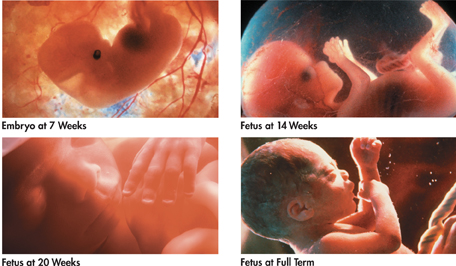Later Development
 What important events occur during the later stages of human development?
What important events occur during the later stages of human development?
Although most of the tissues and organs of the embryo have been formed after three months of development, many of them are not yet ready to go to work on their own. On average, another six months of development takes place before all of these systems are fully prepared for life outside the uterus.
Months 4–6  During the fourth, fifth, and sixth months after fertilization, the tissues of the fetus become more complex and specialized, and begin to function. The fetal heart becomes large enough so that it can be heard with a stethoscope. Bone continues to replace the cartilage that forms the early skeleton. A layer of soft hair grows over the skin of the fetus. As the fetus increases in size, the mother's abdomen swells to accommodate it. The mother begins to feel the fetus moving.
During the fourth, fifth, and sixth months after fertilization, the tissues of the fetus become more complex and specialized, and begin to function. The fetal heart becomes large enough so that it can be heard with a stethoscope. Bone continues to replace the cartilage that forms the early skeleton. A layer of soft hair grows over the skin of the fetus. As the fetus increases in size, the mother's abdomen swells to accommodate it. The mother begins to feel the fetus moving.
Months 7–9  During the last three months before birth, the organ systems of the fetus mature, and the fetus grows in size and mass. The fetus doubles in mass, and the lungs and other organs undergo a series of changes that prepare them for life outside the uterus. The fetus is now able to regulate its body temperature. In addition, the central nervous system and lungs complete their development. Figure 34–23 shows an embryo and a fetus at different stages of development.
During the last three months before birth, the organ systems of the fetus mature, and the fetus grows in size and mass. The fetus doubles in mass, and the lungs and other organs undergo a series of changes that prepare them for life outside the uterus. The fetus is now able to regulate its body temperature. In addition, the central nervous system and lungs complete their development. Figure 34–23 shows an embryo and a fetus at different stages of development.
On average, it takes nine months for a fetus to develop fully. Babies born before eight months of development are called premature babies and often have severe breathing problems as a result of incomplete lung development.

FIGURE 34–23 Human Development At 7 weeks, most of the organs of an embryo have begun to form. The heart—the large, dark, rounded structure—is beating. By 14 weeks, the hands, feet, and legs have reached their birth proportions. The eyes, ears, and nose are well developed. At 20 weeks, muscle development has increased, and eyebrows and nails have grown in. When a fetus is full term, it is capable of living on its own.
Table of Contents
- Formulas and Equations
- Applying Formulas and Equations
- Mean, Median, and Mode
- Estimation
- Using Measurements in Calculations
- Effects of Measurement Errors
- Accuracy
- Precision
- Comparing Accuracy and Precision
- Significant Figures
- Calculating With Significant Figures
- Scientific Notation
- Calculating With Scientific Notation
- Dimensional Analysis
- Applying Dimensional Analysis




